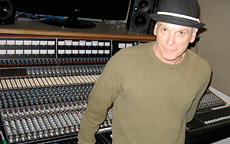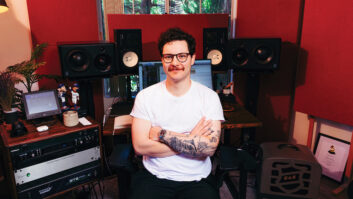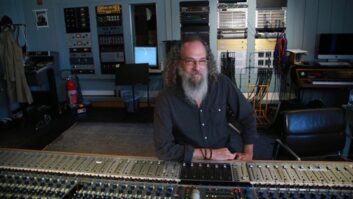
It’s 4 a.m. on November 11, 2009, the morning of the Country Music Association Awards. Sunrise is still more than two hours off, and a few partygoers from the unofficial but enthusiastic pre-event soirées are still wandering unsteadily along nearby lower Broadway, home to the city’s honky-tonks like Tootsie’s Orchid Lounge.
John “JC” Convertino, music mixer for ABC’s ‘Good Morning America’
This is the start of a typical workday for John “JC” Convertino, music mixer for ABC’s Good Morning America, the only one of the three network morning programs that has a staff music mixer. Before he got his union card and started working in broadcast a decade ago, Convertino could be found in New York recording studios, on projects for Talking Heads and Madonna, or mixing reissues such as Velvet Underground’s Another VU album. The level of artists hasn’t changed; on GMA he’s mixed live shows for everyone from Bruce Springsteen to Mariah Carey, but now he arrives at work around the same time he used to leave the studio. And that’s what he’s doing this morning in Nashville, setting up for a performance by Carrie Underwood and Brad Paisley, the co-hosts of the CMA Awards show that will take place inside the Sommet Center later in the day.
“That show is for the industry; this one’s for real people,” Convertino says, nodding toward the stage area that’s already being surrounded by fans who want to get close to the stars. Both the CMAs and GMA draw millions of viewers; the big difference, though, is that GMA does it five days a week, with Convertino mixing a new artist almost daily. “When everyone is ready to go home after a show, I’m getting ready for the next one, collecting microphone maps and equipment lists for what I have to rent for the next show,” he explains.
Setting Up Remotely
With lists in hand, Convertino will sleuth the rental houses; most of the requests mirror the artists’ touring gear, from amplifiers down to the Shure Beta 58 wireless handheld microphones that both Paisley and Underwood use on the road. Their instrumentation is very similar, as well, allowing Convertino to assign them each a layer of the Soundcraft VI-4 digital mixing console inside the Camp Digital remote van that serves as his control room this morning. “There’s very little difference between their setups,” he says, noting that Paisley has a second amplifier rig for his guitar and Underwood’s band has a mandolin player. “So I don’t have to change the returns on the console between performances. I just flip the layers of the console. Carrie’s fiddle player will come up on the same fader as Brad’s.”
For microphone choices and placement, Convertino falls back on his studio experience. “The mics are similar and the placement is the same, but where in the studio I’d use a large-diaphragm condenser, here I’ll use a small-diaphragm,” he says. He likes to use Shure 57s for most of the drum kit, reserving a Sennheiser 602 for the kick. Overheads are the same Shure VP88 stereo condenser microphones both bands use on tour. Paisley’s guitar rig is miked with a combination of a Shure KSM 313 ribbon microphone and an SM57. “I’m seeing a lot more ribbon microphones being used live now,” Convertino comments. “They do a lot to fatten up guitar sounds.”
Monitoring through Adam SA-3 speakers, Convertino⎯who also mixes the live music broadcast for ABC’s New Year’s Eve show from Times Square, near where GMA shoots on weekday mornings⎯did the first rehearsal at 6 a.m. Paisley went first, followed by Underwood; his on-air performance would follow Underwood’s, so Convertino could leave the console set for her after her rehearsal. The rehearsals are recorded to a Pro Tools HD 3 rig in the truck. This is the critical part of the process, where Convertino maps out his moves for the 7 a.m. live teaser from the artist and the 8 a.m. main performance, often with some input from the bands’ FOH mixers. “The rehearsal becomes the template for the performance,” he explains. “I’ll let the band hear the playback and make any adjustments they need to the mix, then switch [Pro Tools] to input and the mix comes right up.”
Uh-Oh…
At least, that’s what was supposed to happen. Even well oiled network gigs can have their own dramatic moments. At 8 a.m., as the last notes of Underwood’s song faded, Convertino toggled the console to Paisley’s rehearsal presets. The crew had three frenetic minutes to flip the stage, during which Paisley yelled out to Convertino, “Hey, JC! You’re out there somewhere and you got to make me sound great!”
Seconds later, though, Paisley’s downbeat was not what Convertino or anyone else was expecting. For whatever reason, the recalled levels were completely different: Paisley’s voice and guitar were way down in the mix, one of the rhythm guitars was overpowering, and the drums were almost nowhere to be found. Momentarily stunned, Convertino and Kevin Freeman, Paisley’s FOH mixer who had been advising Convertino on cues, quickly scrambled to adjust the mix. Before the first verse ended, they had it under control.

From left: Brad Paisley, John “JC” Convertino and Kendal Marcy, Paisley’s keyboardist/banjoist/background vocalist.
Convertino feels sure that he had stored the rehearsal presets properly, but the incident underscores a common occupational hazard for on-air audio mixers working in remote locations on unfamiliar equipment: The ease with which engineers could move between analog consoles is lost with digital desks that, though they all share some basic attributes, have significantly different operational procedures. It didn’t help that this was the first time that Convertino had ever worked on the VI-4. “I don’t think we’ll ever really know exactly what happened,” he acknowledges.
But to the fans in front of the Sommet Center, it was perfect, and their enthusiasm came across loud and clear on the broadcast, which is a big part of creating the excitement of a live mix. Further mitigating the problem was the fact that GMA has a separate feed for each time zone, so only viewers in EDT might have noticed the glitch. By the time it was ready for Chicago, Denver and L.A., Paisley and his band had already run the song down again for Convertino.
“That’s the first time that’s ever happened on air,” Convertino says, but then adds with a laugh, “I think Brad’s shout-out to me was the jinx.”
Dan Daley is a freelance writer based in New York and Nashville.
Visit the 43rd CMA Awards Website at www.cmaawards.com.







